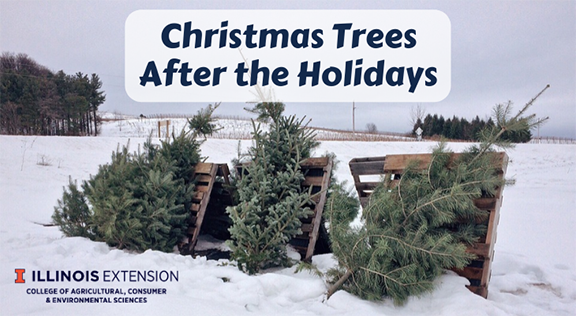By Ken Johnson
All good things must come to an end. Once the Christmas holiday, or in some cases New Year’s, is over, the Christmas tree will need to come down. Instead of hauling off this year’s Christmas tree to the dump right away (or having the city pick it up), consider repurposing it in your landscape.

One popular use for Christmas trees after the holidays is to use them to help feed birds. Trees can be used as a windbreak by placing them to the northwest (the direction our prevailing winds come from this time of year) of feeders. Not only will this help protect birds from the wind as they feed, but it can also prevent birdseed from blowing out of feeders.
If you want to step up your bird feeding game, you can turn your tree into a large festive birdfeeder. Take your old tree and anchor it to the ground using a steel fence post (this may require some elbow grease, especially if the ground is frozen, or perhaps some kids hopped-up on sweets). You can then decorate it with strings of popcorn and/or cranberries as well as pinecones smeared with peanut butter and sunflower seeds, suet, or chopped fruit in a mesh bag. Different types of birds like different types of food, so the more variety you offer, the more diversity you’ll have.
Christmas trees can also be used to create habitat for other wildlife in the form of brush piles. To create a brush pile, start by creating a base of large branches/logs or rocks on the ground. After building your base, place limbs, brush, and in our case, your Christmas tree on top to finish your brush pile. Place brush piles near field borders and in woodland areas along with other brush to provide cover for wildlife. Before you build your brush pile, make sure to check for local ordinances that may prohibit them.
You can also use your Christmas tree to provide habitat for aquatic wildlife. Trees can be sunk in ponds to provide shelter for fish and other aquatic life. A single tree won’t offer much habitat, so it’s best to group three or four trees together when sinking them. Trees should be sunk vertically with rocks or concrete blocks. In shallow lakes and ponds, sink them 6 to 10 feet deep, and in larger lakes 10 to 20 feet deep.
Trees can also be used in a variety of ways in the garden. Evergreen boughs (branches) and needles are commonly used as mulches to cover perennial plants during the winter. These mulches are light and won’t pack or suffocate the roots of the plants they are protecting. If you remove the branches from the trunk, the trunk can be used to edge a garden. Trees can also be chipped and used as mulch in the garden to help reduce weed problems, moderate soil temperature, and help to retain moisture.
Finally, your old Christmas tree can be used in a variety of crafty ways. Us the needles to make potpourri. Dry the branches and remove and crumble the needles. Needles can be mixed with cinnamon sticks and cloves, or used by themselves and placed in a jar and enjoyed year-round. You can also cut the trunk into wooden discs (make sure the wood is dry). These can then be used as coasters or trivets, used to edge garden beds, or decorated and turned into ornaments.
Regardless of how you decide to use your tree after the holidays, just make sure you get all of the ornaments and tinsel off.
Good Growing tip of the week: Your Christmas tree can also be a good source of wood for an outdoor fire. The branches and needles are useful for getting fires started, and the trunk can be used as fuel. Never burn your Christmas tree in a fireplace or woodstove. Burning the tree may contribute to creosote buildup and could cause a chimney fire.

